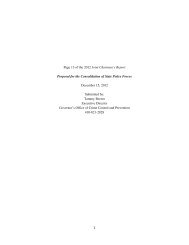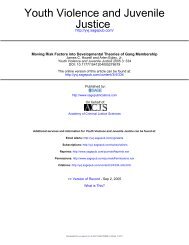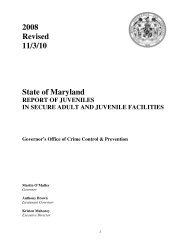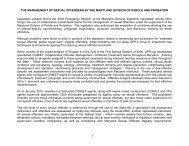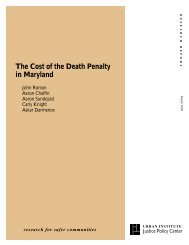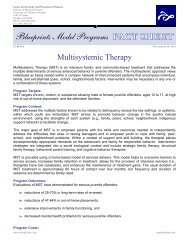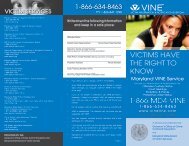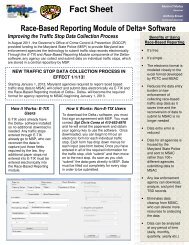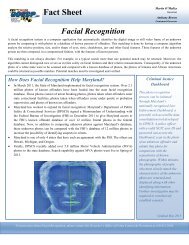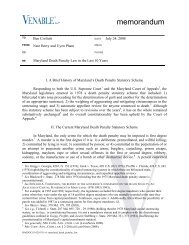Targeted Outreach - Governor's Office of Crime Control & Prevention ...
Targeted Outreach - Governor's Office of Crime Control & Prevention ...
Targeted Outreach - Governor's Office of Crime Control & Prevention ...
You also want an ePaper? Increase the reach of your titles
YUMPU automatically turns print PDFs into web optimized ePapers that Google loves.
12 <strong>Targeted</strong> <strong>Outreach</strong><br />
Figure 1<br />
Gang Risk Factors*<br />
A youth who obtains a score <strong>of</strong> 7 or more points based on the following risk factors is considered at<br />
high risk <strong>of</strong> gang involvement.<br />
Risk Factor<br />
Points Assigned<br />
Gang Behavior<br />
• The youth exhibits gang signs and symbols and indicates that s/he 3<br />
identifies with a gang but does not yet claim s/he is a gang member, nor<br />
is s/he identified by others as such.<br />
Family Issues<br />
• The youth comes from a highly distressed or crisis ridden family from a 2<br />
gang problem neighborhood.<br />
• Youth from families where parents, brothers, sisters, cousins, uncles have 3<br />
been gang members.<br />
Peers<br />
• Youth whose friends are gang members. 3<br />
Youth Behavior<br />
• Youth with a record <strong>of</strong> delinquency. 2<br />
• Youth who hangs out on the streets or in gang neighborhoods with friends 2<br />
who are not necessarily gang members at the time.<br />
• Youth who does poorly in school. 1<br />
• Youth who does not identify with conventional adults or organizations 1<br />
(such as church) or with agencies, such as Boys & Girls Clubs.<br />
• The youth tends to act out, is isolated or has low level <strong>of</strong> self-esteem, 1<br />
especially in his/her pre-adolescent and early adolescent years.<br />
Socio-Economic Status<br />
• Youth is a member <strong>of</strong> a low income family in a racially/ethnically<br />
segregated neighborhood. 2<br />
* Adapted from Spergel.<br />
The GPTTO and GITTO populations were low<br />
income. Of prevention youth, 78 percent qualified for<br />
free or reduced-price lunch, 25 percent lived in public<br />
housing, and 15 percent had no phone at the time<br />
that they were recruited into the Clubs. Intervention<br />
youth were faring about the same, with 72 percent<br />
qualifying for free or reduced-price lunch, 22 percent<br />
in public housing, and 17 percent with no phone.<br />
Law Enforcement Involvement and<br />
Delinquent Activity<br />
As Table 5 (Target Youth’s Participation in<br />
Delinquent Activities at the Start <strong>of</strong> the Program)<br />
reveals, target youth recruited had, in many cases,<br />
demonstrated delinquent activity or had actually been<br />
involved with law enforcement or the juvenile justice<br />
system. Most notably, a quarter <strong>of</strong> prevention (24%)<br />
and more than half (58%) <strong>of</strong> intervention youth had<br />
been picked up by the police, 16 percent <strong>of</strong> prevention<br />
and 38 percent <strong>of</strong> intervention youth had been<br />
put on probation, and 12 percent <strong>of</strong> prevention and<br />
28 percent <strong>of</strong> intervention youth had been placed in<br />
a juvenile facility by the court in the year just prior to<br />
joining the Club/Project. Further, almost one-fifth<br />
(18%) <strong>of</strong> prevention youth and almost half (45%) <strong>of</strong><br />
intervention youth had carried a weapon in the year<br />
before they joined. Substance use was also an issue for



